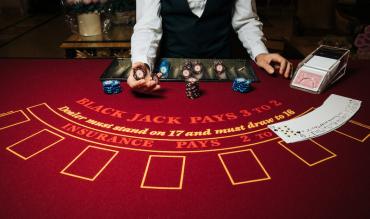As a casino games writer with experience across blackjack, roulette, baccarat, and other table games, I’ve explored strategy, psychology, and decision-making under pressure.
This guide reflects twelve weeks of focused research, live table testing, and cross-referencing expert sources to confirm what truly improves play. It offers clear, adaptable rules for optimum blackjack strategy—built to reduce errors, protect your bankroll, and sharpen decisions when the stakes matter.
Table of Contents
- Blackjack in One Minute: The Fastest Way to Understand the Game
- Essential Blackjack Terms (And Why They Matter)
- The Hidden Rules That Shift Your Blackjack Edge
- Basic Strategy: Your First Big Edge in Blackjack
- Blackjack Charts: Fast Decisions, Fewer Mistakes
- Tricky Hands: Where Most Players Slip
- Shrinking the House Edge: Tactical Blackjack Habits
- Bankroll Rituals: How I Stay in Control at the Table
- Online vs Pit Blackjack: What Changes, What Doesn’t
- Two Hands, One Edge: When to Play Multi‑Hand Blackjack
- Side Bets: Flashy, Pricey, and Sometimes Worth It
- Blackjack Variants: Perks, Traps, and EV Trade‑Offs
- Card Counting: How I Track the Edge and Raise My Bets
- Table Selection and Etiquette: How I Stay Invisible and In Control
- Why Most Players Lose—and How I Patch the Leaks
- Practice Plan: How I Drill for Edge and Accuracy
- Top Blackjack Tips: How I Protect My Edge and Play for Profit
- Final Thoughts on Playing Blackjack
Blackjack in One Minute: The Fastest Way to Understand the Game
Your goal is to beat the dealer without going over 21. Step‑by‑step:
- Bet: Your wager sets the stakes—this is your unit of risk and reward.
- Initial deal: You get two cards; the dealer shows one upcard. Your strategy begins with reading the dealer’s upcard.
- Your turn: Choose hit, stand, double, split, or surrender (if offered). Each move has an expected value—play the math, not emotion.
- Dealer plays: Under fixed rules. No guesswork—the dealer’s path is scripted.
- Settle: Wins paid, pushes returned, losses collected. Blackjack (Ace + 10-value on the first two cards) usually pays 3:2—avoid 6:5. It’s a silent leak.
Variations to note
- In European no‑hole‑card games, the dealer doesn’t take a hole card until after you act, which changes how doubles and splits are treated if they later have blackjack. Insurance/even money is usually a leak unless you’re counting.
- In European games, if you double on 11 and the dealer later reveals blackjack, you lose both bets—no refund. That’s why strategy shifts.
Card values & hand types
- 2–10 are face value; J/Q/K = 10; Ace = 1 or 11.
- Hard hands treat Aces as 1; soft hands use Ace as 11 (e.g., A‑6 = soft 17).
- Soft hands give you flexibility—hard hands don’t forgive mistakes.
Essential Blackjack Terms (And Why They Matter)
- S17 / H17: dealer stands on soft 17 / hits soft 17. Impacts dealer bust rate and your doubling strategy.
- Late surrender (LS): you may give up half your bet after the dealer checks for blackjack/ Lets you cut losses when the dealer shows strength.
- Double after split (DAS): you may double down on hands created by a split. Boosts EV on split hands—especially 8s and Aces.
- Resplit Aces (RSA): you may split Aces more than once if another Ace appears. Maximizes value when multiple Aces appear.
- Penetration: how deep into the shoe the dealer deals before shuffling. Deeper penetration = stronger count accuracy.
- Expected value (EV): the long‑run average result of a decision. The math behind every move—play the long game.
- Variance: natural up‑and‑down swings in results. Explains why good players still lose short-term.
- Running count (RC): the raw total of tags you’ve seen. Tracks card flow—foundation of counting
- True count (TC): RC divided by decks remaining. Adjusts RC for shoe depth—critical for decisions.
- Index play (deviation): a strategy change triggered by a specific TC threshold/ Overrides basic strategy when the count demands it.
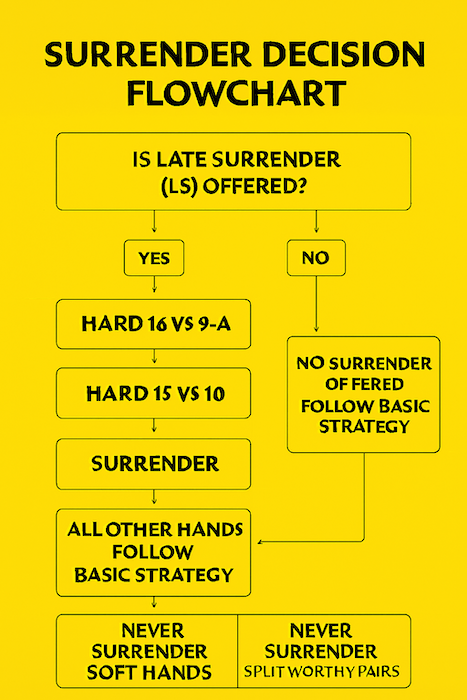
The Hidden Rules That Shift Your Blackjack Edge
What’s coming: A 10-second scan to spot playable tables and skip the traps. Casinos tweak rules; your job is to spot the advantages and disadvantages and work out the possible house edges.
- Blackjack payout: Always prefer 3:2. If I see 6:5, I look for a different table—no exceptions. A £20 blackjack pays £24 instead of £30—over a weekend, that missing £6 adds up fast.
- S17 (dealer stands on soft 17) is stronger than H17—less dealer aggression, more player edge.
- Doubling on any two and DAS tilt the edge toward you—especially on 8s, 9s, and Aces.
- Splits: RSA and multi-splits unlock value—especially when Aces keep landing.
- Surrender: Late surrender (LS) lets you cut losses when the dealer shows strength. Early surrender (ES) is rare but even better—it lets you fold before the dealer checks for blackjack. If offered, take it.
- Decks & penetration: Fewer decks help slightly. Shallow shoes break rhythm—even if you’re not counting, they tilt the game against you.
My filter: payout first, then soft‑17 rule, doubling/splits, surrender, and finally decks and penetration.
Basic Strategy: Your First Big Edge in Blackjack
Why this matters: blackjack basic strategy is the single biggest step toward fairer odds.
Basic strategy is the mathematically best play for each situation. It won’t guarantee wins—but it slashes the house edge. Drill it until you stop guessing and start knowing.
Core reminders
- Always split A,A and 8,8—they’re the only pairs that rescue EV.
- Never split 5,5 or 10,10—5,5 often doubles; 10,10 is already strong.
- Soft hands (A‑2 to A‑7) double vs weak dealer upcards (e.g., A‑6 vs 3–6)—maximize flexibility.
- Surrender saves money: use it on hard 16 vs 9–A and 15 vs 10 (if LS)—don’t fight uphill.
Surrender Essentials
If LS is offered, surrender 16 vs 9–A and 15 vs 10. Never surrender soft hands or split-worthy pairs—those have better paths.
Playbook by Dealer Upcard
- Double 10/11; split A,A / 2,2 / 3,3 / 7,7 / 8,8; hit 5–9 and 12–16 (soft A-2 to A-6); stand 17+ and soft A-7 to A-9.
- Double 10/11; surrender 16 (and 15 vs 10 if LS); stand 17+; split A,A and 8,8; never split 10s—protect your 20.
- Take insurance only with a high count. Hit most stiffs; surrender 16 (LS); double down on 11 when allowed; split A,A and 8,8—don’t fight the Ace, play precision.

Blackjack Charts: Fast Decisions, Fewer Mistakes
- Match your chart to the rules—decks, S17/H17, DAS, surrender—wrong chart means wrong plays.
- Most charts split into three panels: hard totals, soft totals, and pairs—each has its own logic.
- Counting overrides basic strategy—your top indexes rewrite the chart when the count demands it.
- Using a multi-deck chart in a single-deck game can flip your EV—especially on borderline doubles and splits.
Tricky Hands: Where Most Players Slip
- Soft 18 (A‑7): Stand vs 2,7,8; double vs 3–6; hit vs 9,10,A—don’t treat soft 18 like a hard 18.
- Pair 2s: With DAS: split 2–7. Without DAS: split 4–7, hit 2–3 and 8+—adjust for flexibility.
- Pair 7s: Split 2–7; surrender 7,7 vs 10 if LS; hit vs Ace.
- Pair 9s: Split 2–6 and 8–9; stand vs 7,10,A—9s vs 7 is a trap—play it safe.
- Pair 10s: Stand. A 20 is money in the bank—only break it in rare, high-count spots.
- Hard 12: Stand vs 4–6; hit vs 2,3,7–A—don’t fear busting—play the math.
- Hard 15/16: Stand vs 2–6; hit vs 7–8; surrender 16 vs 9–A and 15 vs 10 (LS)—these are your worst hands—cut losses early.
Shrinking the House Edge: Tactical Blackjack Habits
Once you’ve nailed the basics, these habits quietly shrink the house edge—no extra math, just sharper decisions.
- Pick better rules: 3:2 payout, S17, DAS, RSA, late surrender—skip 6:5 and tight doubles/splits; they bleed EV.
- Play basic strategy accurately: Fewer than two errors per 100 hands keeps your edge intact.
- Use surrender when offered: 16 vs 9–A and 15 vs 10—these are your worst hands; cut losses early.
- Control hands per hour: Slow down when you lack edge; speed up (or play two hands) when you’ve got it.
- If you count: Prefer steady dealers, deep shoe penetration, and predictable hand-shuffled games. Avoid continuous shuffle machines (CSMs)—they constantly reshuffle cards after every hand, making counting impossible.
- Stay sharp: Fatigue and alcohol multiply mistakes—protect your edge.
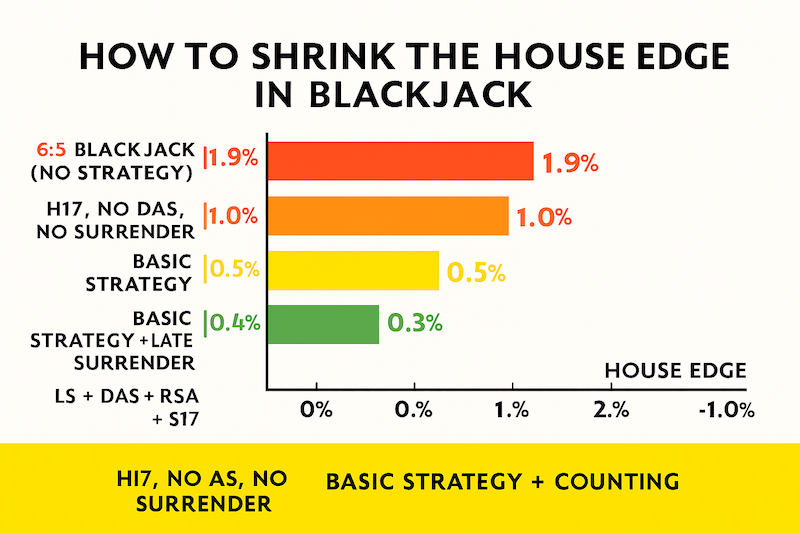
Bankroll Rituals: How I Stay in Control at the Table
What we’ll do: Simple money rules that protect you from cold streaks and keep hot streaks from turning reckless.
- Choose a table where one buy‑in equals 20–40 units—this gives you room to absorb swings and play your edge.
- Keep your usual bet between 1–4 units—adjust only when the count demands it.
- Set your walk‑away number (e.g., 20–30 units) before you play—stick to it—no chasing, no tilt.
Example Bankroll
With a £500 bankroll, a £15 unit gives you approximately 33 units to work with.
Set a stop-loss at £150 (10 units) to manage downside risk.
Win goal is optional—consider £120 as a soft target for session discipline.
Online vs Pit Blackjack: What Changes, What Doesn’t
Why compare: The core game stays the same—but pace, penetration, and scrutiny shift your edge.
- Rules: Always read the felt or rules tab—small print shifts the math.
- Penetration: Live-dealer studios often shuffle early; many pits deal deeper—deeper shoes mean stronger count accuracy.
- Pace: Online is fast; live-dealer is slower—adjust your rhythm and focus.
- Heat (staff scrutiny): Pits watch your bet spreads; online tracks betting patterns—both environments flag deviation.
RNG blackjack vs live‑dealer blackjack
- RNG (random number generator) blackjack: Uses certified random numbers and often offers autoplay/rebet—it’s fast, so use smaller units and take breaks to stay sharp.
- Live-dealer blackjack: Streams real tables—pace is slower; watch for early shuffles and side-bet prompts that dilute EV.
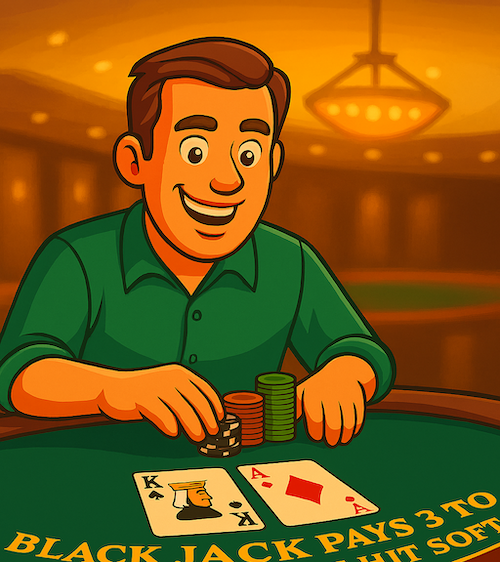
Two Hands, One Edge: When to Play Multi‑Hand Blackjack
Playing two hands can raise your hourly return—especially in deep shoes—but it also raises variance. If you’d bet £30 on one hand, consider two £15 hands to keep risk stable and your edge intact.
In deep shoes with strong counts, two hands let you double your exposure without doubling your risk—just keep your unit size disciplined.
Side Bets: Flashy, Pricey, and Sometimes Worth It
Blackjack side bets are fun but pricey—on average they bleed more EV than your blackjack hand. If I dabble, I keep bets tiny and outside my blackjack bankroll.
- Perfect Pairs / 21+3: Depend heavily on the paytable—read it first; some payouts are worth it, most aren’t.
- Lucky Ladies / Royal Match / Bust: Flashy but usually expensive—they spike variance and dilute edge.
- Insurance / Even Money: Same bet—decline unless a high count justifies it
Blackjack Variants: Perks, Traps, and EV Trade‑Offs
Blackjack Switch
This variant lets you swap the second card dealt to each of your two hands to improve outcomes. In return, the dealer’s total of 22 results in a push against all non-busted hands, and player blackjacks typically pay 1:1. That payout cuts your win on naturals—£20 pays £20 in Switch, compared to £30 under standard 3:2 rules.
Free Bet
This variant offers free double downs on hard 9, 10, or 11—and free splits on most pairs except 10s. In exchange, dealer 22 results in a push against all non-busted hands. The perk feels generous, but the EV trade-off is real: hands that would win on a dealer bust to 22 now tie, and blackjacks often pay 1:1.
European / Single / Double‑Deck
No hole card changes double/split risk. Single/double-deck can be great, but only if payouts and doubles/splits are liberal.
Quick EV Snapshots:
- A 1:1 blackjack pays half a unit less than 3:2
- A 6:5 blackjack pays about 0.3 units less than 3:2
- Dealer 22 = push means hands that would win on a bust now tie
When a variant flashes a perk, I assume there’s a price and I hunt for it before I sit. When in doubt, I play classic 3:2 and protect my edge.
Card Counting: How I Track the Edge and Raise My Bets
Counting cards isn’t magic—it’s a way to raise your bet when the deck is rich and retreat when it’s not. Here’s the plain-English version.
Card counting tracks the ratio of high to low cards left in the shoe. When more high cards remain, doubles, splits, and blackjacks gain value. That’s when I raise my bets—and I bet minimum when the shoe turns cold.
Hi‑Lo (High–Low) basics
- Tag 2–6 as +1, 7–9 as 0, 10–A as −1
- Keep a running count (RC) and convert to a true count (TC) by decks remaining
- Use a simple bet ramp and a short list of high-value index plays—learn 10 first
Advanced counting examples
- True count conversion: RC +8 with 4 decks left gives a TC of about +2. RC +6 with 2 decks left gives a TC of about +3
Why indexes shift EV (Hi-Lo, multi-deck):
- Take insurance when the TC is at least +3
- Stand on 16 vs 10 when the TC is 0 or higher
- Stand on 12 vs 3 when the TC is at least +2
- Stand on 12 vs 2 when the TC is at least +3
- Double 10 vs 10 when the TC is at least +4
Blend in. Let your bets climb naturally, keep the tempo easy, and bow out gracefully if the spotlight finds you.
Most online games block counting, but some live dealer shoes may offer brief windows.
Table Selection and Etiquette: How I Stay Invisible and In Control
The goal: find friendlier games, blend in, and keep the room on your side—so you can play longer and raise your edge without raising heat.
- Favor 3:2 payouts, S17, DAS, RSA, and late surrender—they protect your edge and reduce house traps.
- I prefer calm dealers and steady procedures—if I’m counting, consistency matters more than vibe.
- Sit at first base for pace; third base for extra decision time—choose based on your rhythm and role.
- Stack chips neatly, act in turn, use clear signals. Don’t touch cards in shoe games. Keep drinks off the layout—blend in, avoid drawing attention.
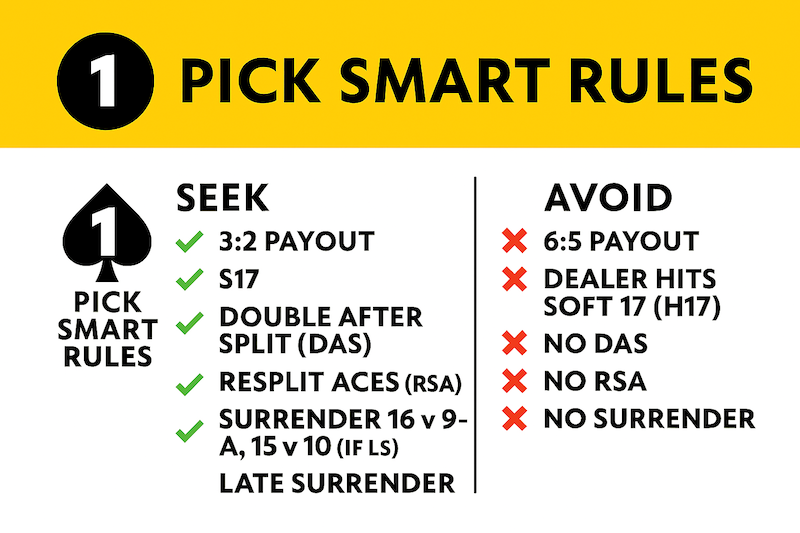
Why Most Players Lose—and How I Patch the Leaks
- Bad rules: Playing 6:5, H17, or no-DAS games drains you slowly—the math bleeds EV hand by hand.
- Leaks: A few basic-strategy errors per shoe erase thin edges—especially in multi-deck games.
- Side bets / even money: Frequent use bleeds expected value—they spike variance and dilute edge.
- Under-bankrolled or tilt: Stakes are too big, or emotions drive decisions—this breaks discipline and shortens your session.
The fix: choose better tables, drill your basics, right-size your unit, and track results by hours and hands—not by feelings.
Practice Plan: How I Drill for Edge and Accuracy
Flash cards: Random hands vs a dealer upcard. Goal: fewer than 2 errors per 100—build muscle memory for basic strategy.
- Decision sprints: Timer at 2–3 seconds per hand for 50 hands—train speed without sacrificing accuracy.
- Deck countdowns: Count down a deck in under 30 seconds, then add distractions—simulate casino noise and pressure.
- RC to TC drills: Pause mid-shoe, estimate decks remaining, and convert quickly—practice true count logic under time stress.
- Simulated shoes: Deal a mock shoe and mark bet raises and deviations—rehearse your ramp and index plays in sequence.
Top Blackjack Tips: How I Protect My Edge and Play for Profit
- Hunt rules first: Favor 3:2 payouts, S17, DAS, RSA, and late surrender—these protect your edge and reduce house traps.
- Play perfect basic strategy: Drill your pain points until they’re automatic—leaks erase thin edges fast.
- Use surrender wisely: Surrender 16 vs 9–A and 15 vs 10—these spots bleed EV if misplayed.
- Skip side bets and even money: Insure only with a high count—variance spikes and EV bleeds otherwise.
- Set a unit: Keep most bets between 1–4 units and use a stop-loss—discipline protects bankroll longevity.
- Consider two hands in good shoes: Split your total wager—raise exposure without doubling risk.
- If you count: Learn Hi-Lo, true-count conversion, top ten indexes, and a smooth ramp—precision beats aggression.
- Blend in and exit cleanly: Review results by hours and hands—not emotion—vocational players track data, not drama.
Final Thoughts on Playing Blackjack
Whether you’re at a physical table or playing live online, strong play starts with rule awareness and edge discipline. Scan for fair tables, follow basic strategy, surrender the worst hands, and manage your bankroll so cold cards don’t drain your session.
Card counting can tilt the odds when the deck is rich—but it’s harder than ever. Casinos use continuous shufflers, shorten the usable portion of the shoe, rotate dealers to disrupt rhythm and tracking, and monitor betting patterns. Online, counting is nearly impossible.
Still, the rules matter. Good ones—3:2 payout, S17, DAS, RSA, late surrender—shrink the house edge. Bad ones—6:5 payout, H17, no surrender—inflate it and bleed EV hand by hand.
Side bets and even money options usually bleed value too—unless you’ve verified the math and the count supports it, skip them.
Follow the habits in this guide and you’ll make fewer costly mistakes, lose less when the cards run cold, and earn more when they run hot. That’s how better players are built—simple, disciplined decisions made consistently, one hand at a time.
If this article interests you, explore other topics like blackjack strategy and roulette strategy.
*** Field-tested and refined: Summer 2025
